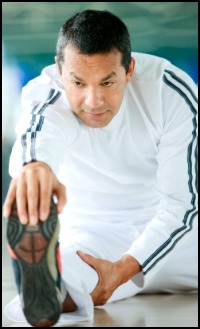The Physiology of Flexibility:
Why You're Flexible (Or Not)
The physiology of flexibility is the science of how and why some people are more flexible than others. Is it purely genetics, or are there other factors?
Weight training is one of the best methods of strength training! If you want to start weight training safely and effectively, with the best info, diet, and routines, check out the 5 Day Beginner Weight Training Course!
Here are the six major reasons why some people can stretch further than others. They are…

Youth And Age
Aging is a major factor in limiting natural flexibility. As you get older, muscles and joints inevitably get stiffer and tighter.[1]
However, we don't know how much of this is genetic vs. lifestyle choices. Having a very sedentary lifestyle will accelerate this process of losing natural flexibility, while being active, exercising, and moving around a lot will keep you limber.[2]
So, move it or lose it! Especially if you keep stretching and moving around, aging will impact you a lot less.
Exercise History
Your history of exercise and activity has a great impact on your own physiology of flexibility. If you spend your time predominantly in an office job or similar occupation, with no cause to use your flexibility, then it will go away.
And if you run on the weekends, play sports, do martial arts, run marathons, etc. you will generally be more flexible than your sedentary friends.
While this isn't something you're born with, don't belittle it. Habit and choices over the course of our life form us far more than our natural abilities.
Gender
Gender also plays a role in the physiology of flexibility, since women are generally more flexible then men. Sorry, guys.
Women have an edge in flexibility partially from nature and partially from nurture. Women have more flexible bodies because of the makeup of their connective tissue, and also because they tend to do activities that focus more on flexibility than brute strength (dancing, yoga, etc.)[3]
Genetics
This is where you just have to roll the dice. Some people are just naturally more flexible (or tighter) than others. Infuriating, isn't it? ;-)
Still, this is something you can't do anything about. So don't agonize over it. For the vast majority of people, genetic variation will not have nearly the impact on you over the course of your life as your habits and practices will have.
Even if you are naturally stiff, if you stretch 10-15 minutes a day, every day, that will make a world of difference.
Level of Muscle Tension
Your ambient level of muscle tension has a great affect on your flexibility. A tense muscle is a short muscle.
Most stretching exercises are devoted to causing your muscles to relax in order to lengthen. Muscles don't actually get longer, their cells just stop contracting. Even though their structure is the same as it was before stretching.
Elasticity of Connective Tissue
Your connective tissues can stretch in addition to your muscles, and help you be more flexible. Or not.
Most connective tissue is susceptible to stretching, but not to the same extent that muscles are.[4] There is something of genetic luck in how elastic your connective tissue is, but beyond that, exercise stretching will help lengthen your connective tissue along with your muscles.
Oh, and be sure to sign up for the e-zine Starting Strong to get monthly strength training, exercise, and diet tips e-mailed to you - and access to the free e-book Train Smart, Eat Smart: Exercise Nutrition Hacks!
• Click here to learn more about Exercise Stretches & Flexibility!
OR
The Physiology of Flexibility: Why You're Flexible (Or Not)
References:
1. Walker, Brad. 2007. The Anatomy of Stretching. Chichester, England: Lotus Pub. Pp. 13.
2. Wharton, Jim, and Phil Wharton. 1996. The Whartons' Stretch Book: Featuring The Breakthrough Method of Active-Isolated Stretching. New York: Times Books. Pp. XXV.
3. Mellion, Morris B., Margot Putukian, and Christopher C. Madden. 2003. Sports Medicine Secrets. The Secrets Series. Philadelphia: Hanley & Belfus. Pp. 95.
4. Hyde, Cheryl L. 2002. Fitness Instructor Training Guide. Dubuque, Iowa: Kendall/Hunt. Pp. 136.
Search CST...
|
Tweet Follow @Aaron_CST |
|
"About 2 weeks ago I read all the ab strengthening stuff on your site because I decided I wanted to be strong, instead of having a lot of belly fat. So I started eating healthier, running, exercising, you name it - everything your site said to do to help. Now I am noticing a real difference! Thank you for making this. :D xD" ~ Julia |
|
[This calorie calculator is] the most useful tool on the web that I can find… Also, I compared the calories calculated by your calculator to the calories calculated by the treadmill at my gym, and they're within a couple calories of each other, so yours is as accurate as we're going to get. REALLY AWESOME TOOL. I love it and depend on it. Thank you sooooo much for making this available." ~ Galit Sharon Marcus |
|
Thank you very much, I was too lean before 2 years (55 Kgs), after the gym now I'm 72kgs, all the muscles have developed... when someone hand shakes with me it can be squeezed easily, they're making fun of me! ~ Tamil Arasan |






New! Comments
Have your say about what you just read! Leave me a comment in the box below.